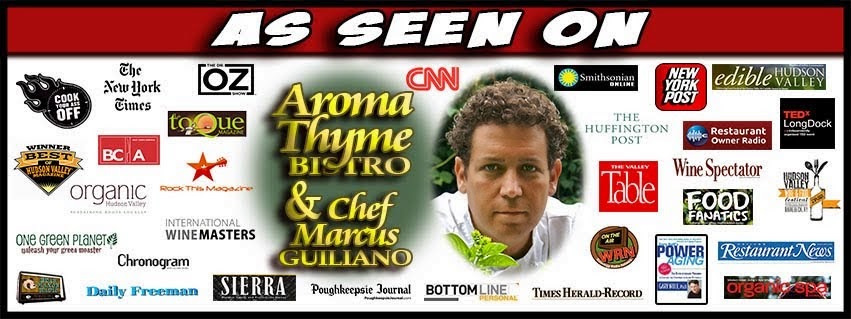
Every now and then a customer at
Aroma Thyme Bistro, up here in Ellenville, asks me the Pinot Noir question:--“What’s so special about Pinot Noir?” Or “Why is it so expensive?”The answer alas is both brutally simple, and pretty darned complicated. Brutal truth:-- Demand enormous, Supply limited. Complexities begin with the fact that Pinot Noir is a fickle, difficult vine to grow and a tricky grape to make great wine with. Pinot Noir is never ordinary. It’s either wonderful or not worth drinking. Flaws in either the fruit or the winemaking can’t be hidden by tricks of the trade, like adding lots of new oak. Then there’s location. The reason why Pinot Noir occupies it’s elevated position in the wine world lies in a band of vineyards, just a few hundred yards wide and about thirty miles long, on an east facing hillside in Burgundy, France. This is the Cote D’Or, literally the “slope of Gold.” This is where those names come from, yes,those names, Chambertin, Richebourg, Bonnes Mares, Romanee Conti, Musigny, La Tache, Clos Vougeot, and so on. Just 30 Grands Crus and a couple hundred Premier Crus, but they resonate in the world of wine like no others. There’s just 10,000 acres of vineyards on the Cote D’Or and not all of themare planted with Pinot Noir. On top of that, great Pinot means a harvest restricted toabout 2.5 tons of fruit per acre. Compared to other varietals this is just about ridiculously restricted. Down in Beaujolais, for example, the get as much as 13 tons per acre of the lowly Gamay grape. Of course, Gamay has been banned from the Cote D’Or since the 15th century. So the search has been on, all over the world, for places to plant Pinot Noir where great wine, burgundian wine, can be made. There have been success storiesin Oregon and California, but the supply cannot keep up with demand. And the result is that great Pinots from the West Coast have reached price levels not far below those of Burgundy, $35 to $100 or much more, a bottle. At the same time, as well as inspiring the movie “Sideways” the love of Pinot Noir has put vines into the ground at a frantic clip. Oregon has maybe 5,000 acres now and California as much as 24,000 acres-- substantially more than France. (odd little fact-- biggest Pinot Noir plantings in France are in Champagne). But fast as they plant ‘em the demand outpaces supply. At Kosta Browne, maker of California’s top ranked Pinots, they’ve doubled supply in the past six years or so, but the waiting list is still 7,000 buyers long. Enter New Zealand. The Kiwi winemakers have already won a place on the world stage with their Sauvignon Blancs, which are as good or better than anyone else’s. Now they’re delivering a slew of solid Pinot Noirs. Over the last decade or so New Zealand’s plantings of Pinot Noir increased to almost 10,000 acres, adding about a Cote D’Or’s worth of Pinot to the world’s pot.Here at Aroma Thyme Bistro we’re still in the process of selecting someNew Zealand Pinot Noirs for the list. Wines we’ve been impressed by includethe Brancott line from Marlborough. There’s the basic Brancott for $11, a Reserve at $18 and a single vineyard wine for upwards of $23. I’ve also enjoyed Mount Difficulty Pinot Noir from Central Otago, which exhibits a stronger herbal side to go with scents of raspberries and other fruits. Then there’s Martinborough Vineyards, Pinot Noir from the North Island with a great nose full of herbs, berries, cherries and even a note of chocolate. But while we work on that (well, someone has to do it) we continue to promote our line of Oregon Pinot Noirs. We have a great set, all deriving from the heart of the Willamette Valley on Route 99W. There’s Archery Summit, Gary Andrus’s startup, in Dayton. Then comes the Argyle winery in Dundee, where they make a terrific line of wines, including the bright, berry scented pinot that we sell.Also in Dundee is the Domaine Drouhin, a famous Burgundian transplant producingterrific Oregon Pinot Noirs. Finally from Newberg, a few miles to the north, comes Rex Hill, which we’ve carried in half bottle and full, and which has a devoted following. Finally, from California’s Central Coast we have Au Bon Climat in half bottle and at the top of the line, Calera’s Jensen Vineyard from Harlan Mountain where it broods over the beauty of the Napa Valley. Chris Rowley





